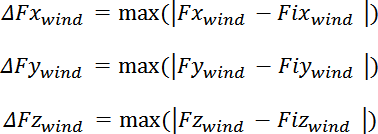Wind simulation does not result in totally stable results as it is a dynamic process changing over time.
In order to address this problem, the program measures the resulting total forces convergence over a specific time period.
Total Forces
- In the direction of the wind:
 .
. - Horizontally and perpendicularly to the wind direction:
 .
. - In the vertical direction:
 .
.
Scaling Forces
The resultant forces depend on the model size. To properly scale the resultant forces, the program uses the dynamic pressure  and the surface values
and the surface values  ,
, , and
, and  .
.
The surface values are used to scale the corresponding forces.
This approach allows for the neutralization of disproportions of the model in the wind directions x, y and z.
-
 Where:
Where: represents the dynamic pressure in pascals.
represents the dynamic pressure in pascals.  represents the fluid density in kg/m3 .
represents the fluid density in kg/m3 .  represents the fluid velocity in m/s.
represents the fluid velocity in m/s.
- The surface
 corresponds to the area covered by the projection of all the triangles of the model on the plane perpendicular to the X wind direction.
corresponds to the area covered by the projection of all the triangles of the model on the plane perpendicular to the X wind direction. - The surface
 corresponds to the area covered by the projection of all the triangles of the model on the plane perpendicular to the Y wind direction.
corresponds to the area covered by the projection of all the triangles of the model on the plane perpendicular to the Y wind direction. - The surface
 corresponds to the area covered by the projection of all the triangles of the model on the plane perpendicular to the Z wind direction.
corresponds to the area covered by the projection of all the triangles of the model on the plane perpendicular to the Z wind direction.
The scaling forces are calculated as follows:

Assessment of resultant forces stabilization
To measure the total forces convergence over a specific time period, the resultant forces  ,
,  , and
, and  are calculated and stored for a number of steps n, and then the maximum change for a given moment is calculated as follows:
are calculated and stored for a number of steps n, and then the maximum change for a given moment is calculated as follows:

Where  ,
,  , and
, and  represent the stored values of
represent the stored values of  ,
,  , and
, and  for a given step, and for i=1 to n.
for a given step, and for i=1 to n.
These maximum force changes are then scaled by  ,
,  , and
, and  respectively and displayed as a percentage.
respectively and displayed as a percentage.
The final metric is the maximum of these three scaled values:

Where  = 0,5%, i.e. the default load deviation factor.
= 0,5%, i.e. the default load deviation factor.
n is the number of simulation steps for which  ,
,  , and
, and  are stored for comparison with the current step. The default value for n is 10.
are stored for comparison with the current step. The default value for n is 10.
